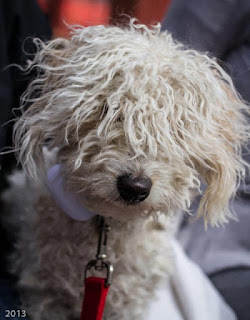Dogs and cats, of all sizes, ages and stripes, keep coming, in cardboard boxes or repurposed birdcages, at the end of frayed ropes, or wrapped in blankets in the arms of their owners. Freaked-out cats howl while some chihuahuas, bug-eyed and trembling, appear to be on the verge of an anxiety attack. For the return trip home, when their dogs might still be a bit woozy from the anesthetic, some owners come prepared with a wheelbarrow.
 |
| Which way to the groomer? |
For the past ten years Stew and I have volunteered for the spay-and-neuter campaigns of
Amigos de Animales, called "blitzes" and held twice or three times a year, and are surprised each year that the stream of dogs and cats showing up remains unabated.
That's good news on two fronts. Sterilizations reduce the number of unwanted and abandoned animals in San Miguel. Continuing demand for Amigos' services is also an indication Mexican pet owners are embracing the spay-and-neuter message.
At the blitzes owners are as varied as the pets: a fancy lady carrying a sweatered poodle; a macho rancher with a cowboy hat and boots escorting a German shepherd; grandmas dragging their equally weary-looking dogs. Most auspicious is the number of kids who bring in their dogs and cats.
At the two-day blitz held last weekend at a Lions Club in San Miguel, one hundred eighty animals were sterilized on Saturday, and another eighty one on Sunday. Since Amigos was formed fifteen years ago by Arno Naumann, an American expat born in Chile, approximately eighteen thousand three hundred animals have been sterilized at the blitzes and at Amigos' mobile clinic.
 |
| "Manchas" ("Spots") and his owner, waiting. |
Doors open at nine but the line begins to form an hour or more before. In Mexico, where waiting in line often seems like the national pastime, owners with their dogs and cats in tow are unfazed by the prospect of a two-hour wait. Street vendors take advantage of the captive clientele.
Stew and I are in charge of weighing all the animals, an important job because weight determines the amount of anesthesia administered. It also gives us the chance to meet each prospective patient and its owner, and provide a leash if the animal comes without one.
Few pure-bred pets show up, though this year we saw at least three pugs, an Irish setter and two litters of blue-eyed Australian shepherds, probably ten in all. Approximately sixty percent of the animals are dogs and the rest cats.
But it's mostly a cavalcade of mutts and generics that defy any categorization. Some are timid, others friendly or scared, very few are aggressive or biters. Some really nervous patients leave behind a memento of their visit. Cats are placed in nylon mesh shopping bags to prevent their escape and to facilitate handling and the injections of anesthetic.
 |
| Under the influence: Pug waiting to be sterilized. |
I kept track of names this year and found some good ones. In an homage to the Orient, a pair of cats were named Yin and Yan, and another one Mao. Interspecies monikers included Abeja ("Bee"), an angst-ridden chihuahua called Lobo ("Wolf"), and a cat named Nemo. Some owners tried their hand at English names: Kreysie and Yak (Jack?). Hollywood was represented by a bitch named Zsa-Zsa and a German shepherd called Doris, and astronomy by two cats called Luna and Venus. My favorite was a cat named Fu. "Fu what?" I asked. Nothing, just Fu.
Almost all of Amigos' funding comes from American donors, though some owners leave small donations as they leave. The vets used to be all local volunteers but most of them are now provided by the State of Guanajuato's Health Department.
 |
| A friendly hand: Cat in the recovery area. |
By eleven o'clock, the assembly line-like operation is running at full steam—owners waiting for the animals to be anesthetized; vet trainees shaving the bellies (or whatever) of the animals; a team of ten vets doing the surgeries; plus owners petting their pets lying in the recovery area. The room begins to look like a bus station, except for the quiet. Occasionally an animal not happy to be injected will shriek, but otherwise the atmosphere is surprisingly calm. As they leave, owners are presented with a small blanket.
Two, possibly three more blitzes are planned for this year, in addition to the mobile clinic making the rounds twice a month of some of the poorer neighborhoods or outlying rural towns.
If the past is any indication, dogs and cats will continue to rain on the spay-and-neuter campaigns of Amigos de Animales. Hallelujah to that.
 |
| Cat in a bag waiting to be registered. |
 |
| The young leading the young. |
 |
| I'm ready to go home, how about you? |
 |
| A rancher pets his German shepherd. |
 |
| This guy is seriously scared. |










Very touching photos with a wonderful story about this program......thanks for all the good that you and Stew do on behalf of animals and people!
ReplyDeleteThank you. And when you return from Houston, we'll have you over so you can meet a few of our campo dogs awaiting adoption. Hope to see you somewhere in Texas when we go there in April.
Deleteal
This is so wonderful, what a great project. I have read of this before. Thank you for being so giving of your time. Cheers
ReplyDeleteThis is a great effort! It's a nice thing to volunteer for. Over its lifetime a male cat can be responsible for over 4000 offspring...
ReplyDeleteThe math is kind of complicated, don't know if it's a geometric or an arithmetic progression. But yes, left to roam, stray dogs and cats can turn into thousands of unwanted animals. Glad you liked the post.
Delete